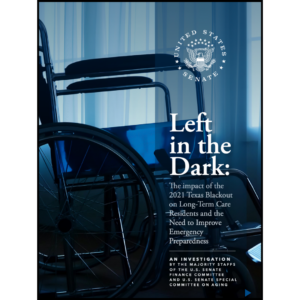Seniors housing: Strategies for a successful transition amid a changing consumerism
Seniors housing is at an inflection point where new products and services must be conceived and implemented to serve a changing consumer profile. This is precisely the time for innovative operators and developers to shine.
A CRISIS IN CUSTOMER ENTHUSIASM
At its core, seniors housing is a consumer product. Its livelihood depends on consistent positive experiences with the “customer,” whether it be residents, their families, hospitals or insurance providers. Ostensibly, customer satisfaction is positive. According to an April 2012 study released by the Center for Retirement Research at Boston College entitled “Cost and Concerns among Residents in Seniors Housing and Care Communities: Evidence from the Residents Financial Survey” that polled over 2,600 residents across 158 communities, the majority of respondents (59 percent) either “strongly agree” or “agree” to the statement “the community offers me good value for my money.” However, upon closer investigation, only 15 percent “strongly agree,” whereas 41 percent either are “neutral,” “disagree” or “strongly disagree.” This implies that for every customer that is enthusiastic about the product, at least 2.5 customers harbor reservations about the value proposition.
Measuring customer enthusiasm, not just customer satisfaction, is becoming increasingly important to leading consumer brands. Satmetrix, a customer relationship software company, created the Net Promoter score, which takes into account the percentage of consumers who feel neutral or worse about a product and those who are highly satisfied. Leading brands, such as Apple and Amazon, have a Net Promoter score of around 75 percent.
 Using the data from the Boston College study, the Net Promoter score for seniors housing is -25 percent. Of the 29 industry segments that Satmetrix tracks, not one of them has a negative average score. Clearly, there is an opportunity for communities to provide outstanding services to residents and their families in new and different ways, especially as conditions and consumer expectations change.
Using the data from the Boston College study, the Net Promoter score for seniors housing is -25 percent. Of the 29 industry segments that Satmetrix tracks, not one of them has a negative average score. Clearly, there is an opportunity for communities to provide outstanding services to residents and their families in new and different ways, especially as conditions and consumer expectations change.
KEY TRENDS IMPACTING CONSUMER BEHAVIOR
Several key trends are impacting consumer behavior. Some of the most significant trends include:
1. Preference for aging in place. Aging in place—defined here as the desire of seniors to stay in a particular residential setting as long as possible—has always been the preference among the majority of seniors. For example, a 2004 study conducted by AARP and MetLife, “The Future of Retirement Living,” found that 86 percent of people over age 65 would prefer to continue living in their home over other alternatives. As aging in place becomes more feasible with the proliferation of home care services and innovative technology solutions, it is likely that seniors will be able to age in place longer in their homes before moving to seniors housing. Similarly, for those in seniors housing, residents may prefer to age in place within independent living longer before moving to higher levels of care.
2. Seniors and their families are significantly less wealthy now than they were five years ago. We have yet to see the full depth of the impact of the recession and housing crisis. The Federal Reserve recently released a report indicating that the median net worth of American families fell 39 percent between 2007 and 2010, to $77,000, a level not seen since 1992. This change has impacted both seniors and their adult children, both of whom are often contributors to the cost of long-term care for seniors. As a result, most seniors will be even more focused on the absolute cost and customer value proposition than they were even five years ago.
3. Seniors have an increasingly negative view of the future. According to a 2012 study released by Zillner, a marketing company focusing on seniors, two-thirds of seniors polled in 2011 had a pessimistic outlook on the economy whereas only 44 percent had a pessimistic view in 2009. The study also identified healthcare coverage and associated costs, unemployment and Social Security as rising concerns. As a result, seniors are more likely to be conservative about their expenditures, including seniors housing.
STRATEGIES FOR SUCCESSFUL OPERATORS AND DEVELOPERS
These trends offer an opportunity for progressive operators and developers to create products and services that differentiate themselves in this new market environment. Suggested strategies to consider include:
1. Design physical spaces to complement operating philosophy. For developers and operators, now is the time to re-imagine what is possible in physical design and operating ethos to put forth a fresh and new value proposition to the consumer. Given all the changes listed above, it may be more valuable to start afresh with new ideas than to replicate or slightly modify existing models. Deciding on an operating philosophy may be the most important step. Then, follow with a physical design of the community that complements the philosophy accordingly. For example, if the operating philosophy is to facilitate aging in place within independent living, the design of the unit should carefully anticipate various health conditions of a resident and help manage care in an efficient way so as to minimize cost.
2. Carefully monitor outcomes. With the rise of higher-acuity residents in lower-care settings, the onus is on seniors housing communities to show exactly how much better their community is for maintaining health compared to other available housing and care options, including a person's own home. For example, are there ways to show that falls are less likely? Is adherence to medications better? Is the risk of social isolation mitigated? It is important that providers identify which questions and pieces of data are most important and then set up systems to track performance.
3. Track the customer experience. Referrals are the lifeblood of seniors housing communities. Referrals also help protect communities from being seen as commodities. Communities should evaluate more closely their customer experience to enhance the odds of strong referrals. Leaders should understand which factors drive consumer enthusiasm and invest resources in these areas. On the other hand, it is equally important to identify areas that are being over-resourced relative to their importance to the consumer. For example, are traditional activities, such as Bingo, appropriate for today’s resident? If not, what are the best ways to engage and stimulate today’s seniors?
4. Innovate to identify “better, faster and cheaper” options. Finding ways to do things more efficiently will be critical to serving the aging population. Technology has a role in these improvements. Operators must carefully identify areas of inefficiency and cost and collaborate with technology solution providers to find new ways to achieve better results. Successful case studies exist, such as the significant labor savings that long-term care staff scheduling company OnShift has provided operators, but this approach will require different thinking and a willingness to collaborate and innovate.
5. Reframe the sales and marketing approach. Sales and marketing professionals must be able to articulate clearly the value proposition of their communities. Increasingly, these individuals must be knowledgeable about the healthcare needs of their prospective residents and be able to explain why their community is uniquely positioned to provide the best care environment. The days of order-taking are long gone.
STRATEGIC EXAMPLES
A number of innovative strategies are working in today’s environment. Trilogy Health Services, for example, develops and operates communities in smaller Midwest markets that blend the best of skilled nursing and assisted living into one campus. They provide a healthcare continuum (often without independent living) that many seniors in these markets can afford. Brookdale Living, the largest seniors housing operator, has developed clusters of communities and has focused on providing ancillary services, such as rehab, to facilitate aging in place within their communities. Holiday Retirement has significantly increased its occupancy over the last two years by lowering their prices as appropriate and focusing on articulating their value proposition as the low-cost leader for independent living in their markets.
CONCLUSION
Seniors housing is morphing. The consumer preference for aging in place within and outside of seniors housing is one of the key drivers for these changes. Equally important is heightened focus on affordability and value for seniors and their families. Best-in-class operators and developers must understand the implications of these key industry trends promptly and move quickly to identify and implement viable strategies for continued success. As Charles Darwin said, “It is not the strongest of the species that survives, nor the most intelligent, but the one most responsive to change.”
Ryan Frederick is the founder and principal of Point Forward Solutions, a strategic consulting firm serving the seniors housing and care industry. His recent whitepaper, “Why Aging in Place Matters,” is available at www.pointforwardsol.com
Related Articles
Topics: Articles , Design , Executive Leadership , Facility management , Housing , Operations











